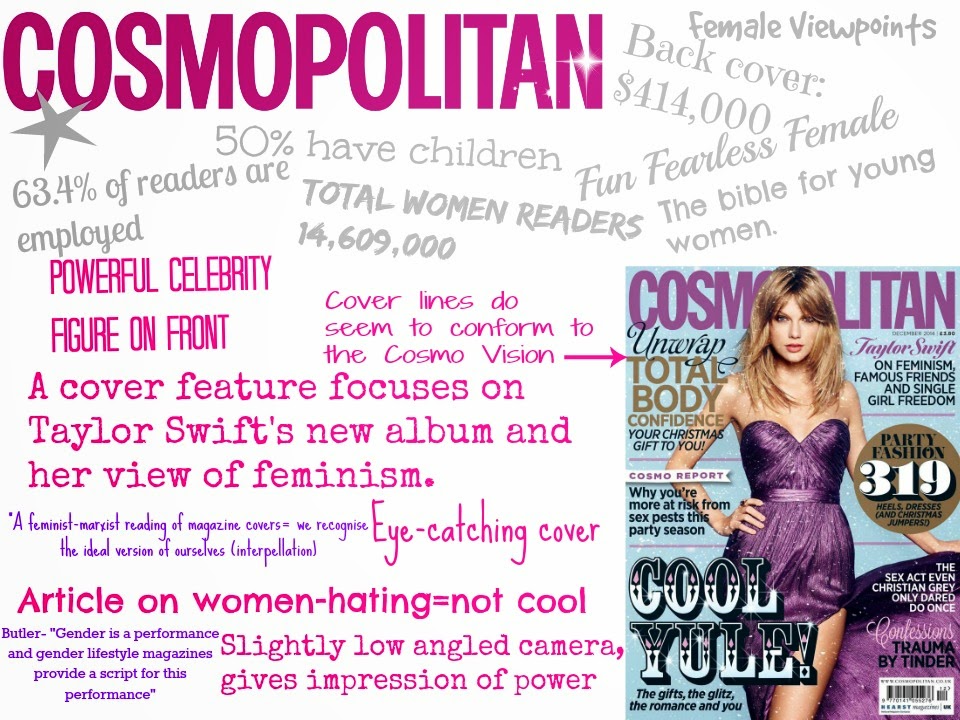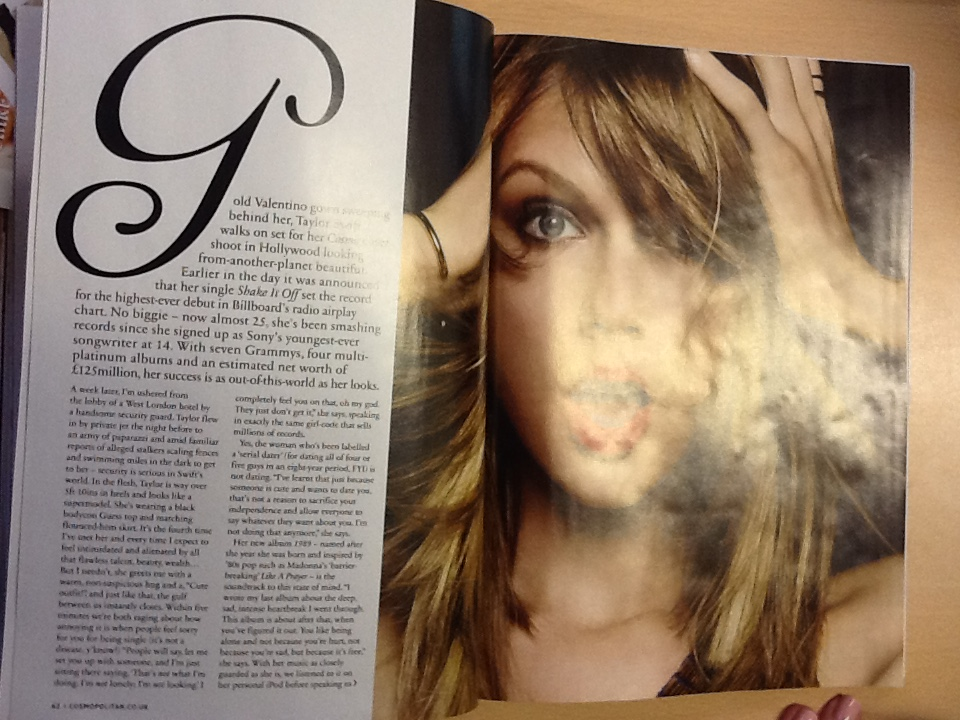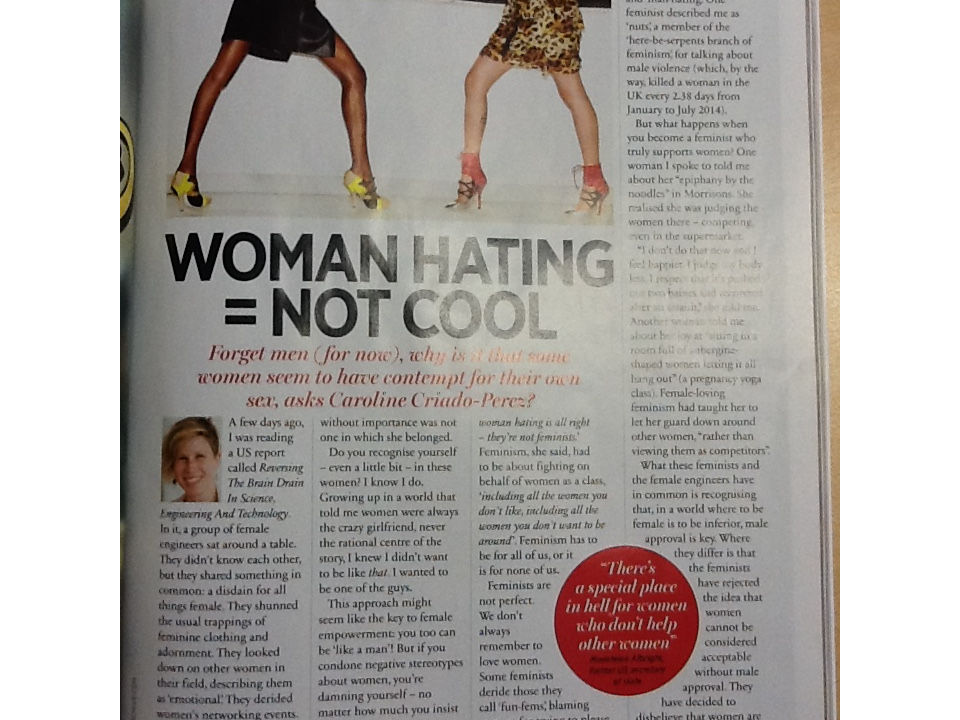Today we looked at Mrs Williams' guide on how to get full marks in section 1 of the exam. Here is the video we watched:
Thursday 20 November 2014
Monday 17 November 2014
Representation of Women in Magazines
I undertook a sustained analysis of the December 2014 issue of 'Cosmopolitan' magazine, looking at how the magazine creates a sense of belonging for its readers. I bore in mind that post-modern readers play with gender identity and so can pick and mix the meanings of the representations in the magazine.
We first conducted a semiotic analysis of the cover page of 'Cosmopolitan' and discovered that Taylor Swift appears on the cover, a strong independent woman who is admired by many people of our society, and readers of the magazine. The image displayed on the cover shows Taylor with her hand on her hip wearing a long dark, sparkly purple dress, with a long slit up the side, presents her as a confident, glamorous, assertive woman- something that the readers of Cosmo can aspire to. This image is taken from a slightly low camera angle which helps to present the power of women today, as well as helping to portray Taylor Swift as an aspirational figure.
We then looked at the colours and fonts on the cover and throughout the magazine. It is clear by the feminine pinks, purples and pale blues that 'Cosmopolitan' is directly aimed at a female audience. Its media pack supports this idea as it states that more than 14 million readers each month are female. The fonts used range from clear bold sans-serif font to fancy, decorative, feminine fonts.
Then we examined the cover lines, we found out that they all entice the reader. Examples such as 'Taylor Swift on Feminism' further shows that 'Cosmopolitan' aims towards the female audience as well as mentioning relevant issues in the media today, such as Emma Watson's UN speech about Feminism. The media pack supports this as it calls the magazine 'the bible for young women', and wanting to empower these female readers helping them to live 'fun and fearless lives'. The way in which other cover stories present ideas about sex, such as 'The great sex act even Christian Grey only dared to do once', helps to show that the magazine is trying to act as a friend to the reader, encouraging them to talk about private, intimate things. Additionally Cosmo prides itself in addressing previously taboo issues which are important to women.
When we continued our analysis inside the magazine we found even more articles about fashion, lifestyle, diets, sex and celebrity gossip- all of which are important to the regular readers of Cosmo. The articles include one (mentioned on the cover) about Taylor Swift's feminist feelings. She explains how previously she was never sure about being a feminist, but now, after hearing Emma Watson's UN speech on gender equality, she is proud to call herself a feminist, and sees her as a role model, much like Taylor Swift is a role model for the readers. The magazine also includes another article titled, 'Women Hating = Not Cool' and explains more about another persons feminist views, and treats Cosmo as a club where women with those views can join and feel appreciated by society, as Winship says "A magazine is like a club. Its first function is to produce readers with a comfortable sense of community and pride in their identity". A feminist/Marxist reading of women magazines in general suggests that women are told what to think by magazines, which distracts them from really important issues yet 'Cosmopolitan' contradicts this view in articles like 'Women Hating=Not Cool' by bringing those issues into the spotlight.
A comparison with 'Women's Health' magazine is significant as this conforms more consistently to the Marxist theory. The cover lines on the December 2014 issue are didactic (give you instructions), using imperatives such as 'Shed One Size','Join the New Clean Club Scene' and 'Burn Fat'.
Singer, Frankie Bridge, is featured on the cover. She is seen as a role model due to the way in which her abs are on show and she is perfectly toned, something aspirational for the 'Women's Health' readers. This also conforms to the marxist idea of interpellation (mis-recognising yourself). Women who read this magazine wish to see themselves as 'being' Frankie Bridge, although totally impossible, they aspire to obtain an image similar to hers. The magazine is presented rather like an instructions manual, telling you what to do, what to eat, what to wear etc. and by playing on peoples insecurities.In this way,
Judith Butler's theory applies, which says that "Gender is a performance & gender lifestyle magazines provide the script for the performance".
Furthermore, Gramsci's 'uses and gratifications' theory can be applied here, in that the readers are using the magazine media to conform to a hegemony (a given set of beliefs and ideas that we all accept and live by- i.e. you should be slim & fit). An example of this is the cover story about Strictly's Frankie Bridge, which is followed up by an article called 'Get Fit Like Frankie' and provides the reader with work-outs in order to become toned, as the photo on the front displays.
In comparison, our analysis of 'Men's Health' magazine revealed slightly different dominant discourses. The cover lines confirmed four key discourses, such as '5 minute energy boosts' for quick fit problem solving; '1 instant age eraser' for male narcissism and anxiety; '21 women you need in your life'(the women featured include Angela Merkel and Dame Sarah Storey, it emphasises the with the strap line 'let them teach you how to be a real man') for new male sensitivity; and 'how to hit on a supermodel' for male superiority.
Despite gestures towards 'new men', the cover photos are always in black and white, because the editors assume that the heterosexual readership will feel more secure with this as the black and white male torso has connotations of being less sexual and more mechanical, this is because is emphasises the muscles on the model. This supports the idea that magazines reassure readers that they have made the right lifestyle choices.
Judith Butler's theory applies, which says that "Gender is a performance & gender lifestyle magazines provide the script for the performance".
Furthermore, Gramsci's 'uses and gratifications' theory can be applied here, in that the readers are using the magazine media to conform to a hegemony (a given set of beliefs and ideas that we all accept and live by- i.e. you should be slim & fit). An example of this is the cover story about Strictly's Frankie Bridge, which is followed up by an article called 'Get Fit Like Frankie' and provides the reader with work-outs in order to become toned, as the photo on the front displays.
In comparison, our analysis of 'Men's Health' magazine revealed slightly different dominant discourses. The cover lines confirmed four key discourses, such as '5 minute energy boosts' for quick fit problem solving; '1 instant age eraser' for male narcissism and anxiety; '21 women you need in your life'(the women featured include Angela Merkel and Dame Sarah Storey, it emphasises the with the strap line 'let them teach you how to be a real man') for new male sensitivity; and 'how to hit on a supermodel' for male superiority.
Despite gestures towards 'new men', the cover photos are always in black and white, because the editors assume that the heterosexual readership will feel more secure with this as the black and white male torso has connotations of being less sexual and more mechanical, this is because is emphasises the muscles on the model. This supports the idea that magazines reassure readers that they have made the right lifestyle choices.
Gender Inequality in Film
Here is an article I found on Pinterest all about gender inquality in film.
(Make sure to click on it and zoom in to make the image clearer!)
Thursday 13 November 2014
Monday 10 November 2014
Representation of Women in Magazines
In todays lesson we looked at how women are represented in the magazines, 'Cosmopolitan', 'Mens Health' and 'Womens Health' and we compared the 3 magazines to see their similarities and differences.
We discovered that men's magazines use bold
colours and black and white photos to look more 'butch' and 'male', however women's magazines use
softer colours and fancy fonts to create a more 'feminine' effect. The 'Womens Health' magazine made us feel rather depressed becasue of the unrealistic image it portrayed by the endless diet plans and 'what not to eat at Christmas' articles! However 'Cosmopolitan' directly addresses the
powerful representation of women with articles about the feminist feelings of celebrities such as Taylor Swift (See below). It still presents an idealistic female figure and some diet information, however this is not presented in such a blunt manner, but in a much more motivational way.
Sunday 9 November 2014
Thursday 6 November 2014
Feminism Powerpoint
Recently, I did an assembly on the role of women in society and feminism. Here it is:
Tuesday 4 November 2014
What Am I?
As part of our introduction to the Collective Identity topic we had to think about what groups we could belong to to make up who we are. We put it into a pie chart using Microsoft Excel in order to compare our different roles in society.
Subscribe to:
Posts (Atom)






